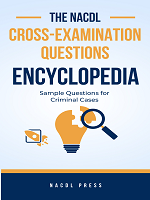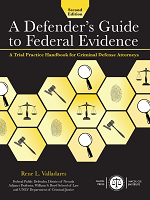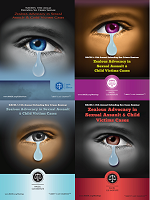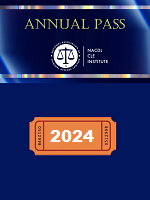Access to The Champion archive is one of many exclusive member benefits. It’s normally restricted to just NACDL members. However, this content, and others like it, is available to everyone in order to educate the public on why criminal justice reform is a necessity.
There was a time in America when at least one in five defendants stood up to overcriminalization by taking their cases to trial. Edward Bennet Williams — who co-founded the firm of Williams & Connolly, and who died in 1988 — is widely hailed as among the finest trial lawyers of his era because of his successes at trial. It has been said that one of the keys to his success was that at the outset of a case he got all the lawyers together to convince them not to plead out their clients.
But those days are past. For alleged associates of organized crime, “doing five years standing on their head” ceased to be their mantra when they were faced with 20-year sentences for racketeering. People facing drug charges began to fold with the enactment of statutes carrying heavy mandatory minimum sentences. People charged with economic crimes saw the writing on the wall when courts ceased sentencing businesspeople to probation as a consequence of harsher sentencing guidelines.
When we began practicing law, 20% of the cases went to trial. For the last 10 years, that figure has been less than 3% due to coercive plea bargaining.
The Pew Research Center’s (PRC) analysis of pleas entered in fiscal year 2022 reveals that of the 71,954 defendants in federal criminal cases, 89.5% pled guilty, while another 8.2% had their cases dismissed. Because PRC’s data included pleas to misdemeanors, the percentage of those who pled guilty to felonies is over 90%. Only 290 of the 71,954 defendants — just 0.4% — went to trial and were acquitted.{1} 1 Fewer Than 1% of Federal Criminal Defendants Were Acquitted in 2022, Pew Research Center, June 14, 2023, https://www.pewresearch.org/short-reads/2023/06/14/fewer-than-1-of-defendants-in-federal-criminal-cases-were-acquitted-in-2022/.
Thus, it is not just the fear of draconian sentences that compels defendants to plead guilty; it is also the near certainty of conviction if they take their case to trial. However, recent acquittals in complex federal white collar cases gained by the co-author of this column, Michael Heiskell; NACDL Executive Director Lisa Wayne; and numerous NACDL members such as Wendy Anderson, Juanita Brooks, Drew Findling, David Gerger, Jeff Kearney, and David Markus provide strong reason for hope and impetus for defense counsel and their clients to consider taking their case to a jury.
Mandatory minimums and sentencing guidelines would not account for all these pleas were it not for one overriding factor: credit for assistance to the government. Whether it be as a result of the safety valve or substantial assistance, helping the government make a case against others is the key to escaping from a mandatory minimum sentence and a departure under the sentencing guidelines or a significant variance from them. This applies whether the cooperation leads to pleas from co-defendants or the conviction of co-defendants at trial. And it is the synergy between the push of draconian sentences and the pull of variances and departures that combines to convince so many to surrender.
This pressure leads to two results. One is that defense attorneys inform their clients that there is a slight chance that they can win at trial, even where the client insists that he or she is innocent and the government’s case seems shaky, at best. It also puts some defense counsel under pressure to convince the client that it is better to plead guilty because the lawyer understands far better than the client the consequences the client will face from a conviction after trial. Lawyers will also advise their client that the early bird catches the biggest benefits from the government. So, as a result many lawyers become an instrument of the government’s coercion.
Thus far we have been talking about the federal system, but the situation in the states is much the same. The fear of crime resulting from increasing crime rates in the ’70s and ’80s, stoked by politicians engaged in an arms race to portray themselves as the toughest on criminals, and news accounts that became ever more sensational led to the enactment of oppressive penalties. Law enforcement funding soared, including surges in the hiring of prosecutors (without equitably balanced funding for defenders), while public defenders who represented the majority of offenders saw their caseloads skyrocket.
Although the numbers vary from state to state — the felonies prosecuted tending more toward violent street-level offenses, and the arrests, prosecutions, pretrial confinement of defendants involving far more misdemeanors — the percentage of state-level defendants pleading guilty is roughly the same as at the federal level. Pleading guilty is almost the only way to avoid it or reduce state prison time, which is hard time indeed.
Given these dynamics in state and federal courts, we as members of the criminal defense bar must ask: How can we best represent our clients at the highest level, and what must we do to become better?
As a start, we need to address how the nature of our representation changes depending upon whether the prosecutor’s evidence is overwhelming, whether we believe our client is guilty but the prosecutor’s case is shaky, or in the worst-case scenario, we believe our client is actually innocent of the charges.
The first scenario is easy, especially where our client does not dispute guilt. And even when the client does, it is the client’s decision to roll the dice. The second and third situations are where the pressure mounts on us. In the second scenario, do we urge our client to go to trial or focus on the consequence of a conviction? In the third, what if the client insists on his or her innocence and we believe it, but the client is afraid of what will happen if he or she goes to trial and is convicted? Can we plead an innocent person guilty? Can we ethically allow our client to affirm in court a factual basis for a plea we know to be false? What about our obligation as officers of the court (a consideration which is admittedly of lesser importance than our fear of an innocent person going to prison)?
These are the known, unknowns. If we believe our client to be innocent, do we go to the prosecutor and lay all our cards on the table? The conventional wisdom used to be: “Save it for the trial.” Back when a significant number of cases went to trial, the fear was that presenting our defense to the prosecutor would just give the prosecution a preview of our evidence that would help the government prepare to refute it. But given today’s reality, in representing an innocent defendant, we may feel obligated to proffer our case to the prosecutor. The downside, of course, is that if not handled properly, an effort to convince the prosecutor that the defendant is innocent could squelch a plea if the prosecutor insists on speaking to the client and concludes the client is lying.
There are lawyers who have been successful in convincing prosecutors that their clients were innocent, and prosecutors have either halted their investigation or dismissed charges, even on the eve of trial. But many lawyers have never even tried to change a prosecutor’s mind, and many who have tried are not aware of the various approaches that have worked.
Very soon, every U.S. Attorney’s Office will have a pretrial diversion program. In some districts it will be a separate unit staffed with its own prosecutors. Each district will have its own criteria for eligibility. Once those programs begin (and in some districts they already have), lawyers will need to hone skills to ensure that their clients fall within the class of offenders that these programs allow. In cases where clients qualify, this is an opportunity to walk away from this chapter in their lives without a criminal record.
What should we do in the face of inherently coercive plea bargaining? In virtually every plea, it could be argued that lawyers commit ineffective assistance of counsel because they are compelled to advise their clients without the benefit of full discovery and even Brady evidence. Yet this does not have to be the case. The enactment of the Due Process Protection Act of 2020 and its amendment to Rule 5 of the Federal Rules of Criminal Procedure provides an opportunity to argue that the decision of the Supreme Court in United States v. Ruiz,{2} 2 536 U.S. 622 (2002). holding that the government is not obligated to provide the defense with impeachment material during plea negotiations, has been superseded by legislation.
Although the Court in Ruiz made a distinction between evidence of actual innocence and impeachment material, the court did not confront the fact that in many cases a conviction rests upon false testimony by government witnesses, and that the only way to convince a jury of the truth is to confront these witnesses with the very impeachment material that the prosecutors are permitted to hide.
Even if that effort fails, there are other ways to force prosecutors to play fair. Those tactics are beyond the scope of this column. However, they are addressed in detail in a terrific article in the August 2023 issue of The Champion, “Defenders Getting Their Due in Pursuit of Mr. Brady,” by Natasha Perdew Silas, co-dean of the National Criminal Defense College. This article should be mandatory reading in law schools and for any lawyer who ever engages in plea negotiations. We can also be thankful that the Plea Bargaining Institute has recently been formed. Its goal is to improve the sharing of academic research on plea bargaining with advocates and practitioners, who in turn can use their own real-world experiences to seek new avenues of research from academics studying this important issue.
Finally, let’s look at sentencing. Today, the court has the ability to do justice. It is incumbent upon us to give the court the ammunition it needs to support a favorable sentence for our clients. When cases went to trial, judges had the opportunity to observe the defendant over the course of weeks, months, and sometimes years. They may not have gotten the full picture, but they saw how the defendants comported themselves in court and interacted with their lawyers and family members. The judge also saw the evidence firsthand and had a better sense of the defendant’s true degree of culpability than might otherwise be reflected by the cherry-picked facts cited in the prosecution’s sentencing recommendation.
In these circumstances, we must make the defendants come alive for the court. We no longer need to just stand there, address the guidelines, point out how aberrational the defendant’s conduct was, and talk about all the letters of support. We can put on a defense, not to the defendant’s guilt, but as to the defendant’s true degree of culpability. We can present hearsay evidence by witnesses who are afraid to come forward. We can provide the judge with photos and a video showing the defendant’s life outside of court. There is so much more we can do today, and we can learn a lot from lawyers and mitigation specialists who handle capital cases.
So, let us stop filing the same old sentencing memos and reciting the same old cases that bring us to this moment. Instead, dive straight into your client’s unique life story and offer compelling reasons your client deserves a specific sentence factoring in elements of justice and mercy, and not just a generic sentence without reference to the whole picture. We can and must be better at this.
NACDL is committed to eliminating the trial penalty — the profoundly coercive difference between a pretrial settlement offer and a post-trial sentence. Go to https://www.nacdl.org/TrialPenalty to read the NACDL trial penalty report and find related resources.
About the Authors
Michael P. Heiskell is the owner of Johnson, Vaughn & Heiskell in the Fort Worth-Dallas, Texas area. He represents individuals and entities in state and federal courts throughout the country, with an emphasis on white collar investigations and prosecutions. He is a past president of the Texas Criminal Defense Lawyer’s Association.
Michael P. Heiskell (NACDL Life Member)
Johnson, Vaughn & Heiskell
Fort Worth, Texas
817-457-2999
mheiskell@johnson-vaughn-heiskell.com
www.johnson-vaughn-heiskell.com
Jon May leads Creative Criminal Defense Consultants in Boca Raton, Florida.
Jon May (NACDL Member)
Boca Raton, Florida
954-439-6500
jonmay.criminaldefense@gmail.com
www.jonmaycriminaldefense.com






